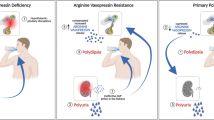Summary
When tracer Na+ is added to the solution bathing the apical side of isolated epithelia the observed transepithelial tracer influx increases with time until a steady state is reached. The build-up of the tracer flux follows a single exponential course. The halftime for this build-up under control conditions was 0.92 ±0.06 min, and in the presence of ouabain 4.51±0.7 min. It is shown that the calculated Na+-transport pool is located in the cells. The Na+-transport pool under control conditions was 35.6 ±3.4 nmol/cm2, which corresponds to an intracellular Na+ concentration of 7.9mm. Activation of the active Na+ transport by addition of antidiuretic hormone resulted in a highly significant increase in the Na+ transport pool, and inhibition of the transcellular Na+ transport with amiloride resulted in a decrease in the Na+-transport pool.
Furthermore, the active Na+ transport increased along anS-shaped curve with increasing intracellular Na+ concentration (Na+-transport pool). The Na+ pump was found to be half saturated at an intracellular Na+ concentration of 12.5mm.
Similar content being viewed by others
References
Biber, T.U.L., Cruz, L.J., Curran, P.F. 1972. Sodium influx at the outer surface of frog skin. Evaluation of different extracellular markers.J. Membrane Biol. 7:365–376
Candia, O.A., Reinach, P.S. 1977. Sodium washout kinetics across inner and outer barriers of the isolated frog skin epithelium.Biochim. Biophys. Acta 468:341–352
Carasso, N., Favard, P., Jard, S., Rajerison, R.M. 1971. The isolated frog skin epithelium. I. Preparation and general structure in different physiological states.J. Microsc. 10:315–330
Cereijido, M., Herrera, F.C., Flanigan, W.J., Curran, P.F. 1964. The influence of Na concentration on Na transport across frog skin.J. Gen. Physiol. 47:879–893
Crank, J. 1956. The mathematics of diffusion. p. 45. Oxford University Press, London
Erlij, D., Smith, M.W. 1973. Sodium uptake by frog skin and its modification by inhibitors of transepithelial sodium transport.J. Physiol. (London) 228:221–239
Dainty, J., House, C.R. 1966. Unstirred layers in frog skin.J. Physiol. (London) 182:66–78
Garay, R.P., Garrahan, P.J. 1973. The interaction of sodium and potassium with the sodium pump in red cells.J. Physiol. (London) 231:297–325
Hoshiko, T., Lindley, B.D., Edwards, C. 1964. Diffusion delay in frog skin connective tissue: A source of error in tracer investigations.Nature (London) 201:932–933
Hoshiko, T., Ussing, H.H. 1960. The kinetics of Na24 flux across amphibian skin and bladder.Acta Physiol. Scand. 49:74–81
Koefoed-Johnsen, V. 1957. The effect ofg-strophantin (ouabain) on the active transport of sodium through the isolated frog skin.Acta Physiol. Scand. (Suppl.)145:87–88
Koefoed-Johnsen, V., Ussing, H.H. 1958. The nature of the frog skin potential.Acta Physiol. Scand. 42:298–308
Kotyk, A., Janácek, K. 1975. Cell Membrane Transport. Plenum, New York
Larsen, E.H., Fuchs, W., Lindemann, B. 1979. Dependence of Na-pump flux on intracellular Na-activity in frog skin epithelium (R. esculenta).Pfluegers Arch. 382:R13
Lewis, S.A., Wills, N.K. 1980. Interaction between apical and basolateral membranes during Na+ transport across tight epithelia.J. Gen. Physiol. 76:3a
Macknight, A.D.C., Leaf, A. 1978. The sodium transport pool.Am. J. Physiol. 234:F1-F9
Nagel, W., Dörge, A., Moshagen, D., Rick, R. 1974. Analysis of sodium compartments and fluxes in frog skin.Naunyn-Schmiedeberg's Arch. Pharmacol. 281:281–294
Nagel, W., Garcia-Diaz, F., Armstrong, W. McD. 1980. Intracellular ionic activities of frog skin.Fed. Proc. 39:1080
Nagel, W., Moshagen, D. 1978. Wash out characteristics of tracer Na from the transport pool of frog skin.Pfluegers Arch. 374:235–241
Parsons, R.H., Hoshiko, T. 1971. Separation of epithelium from frog skin and rapid washout of22Na.J. Gen. Physiol. 57:254–255
Rick, R., Dörge, A., Arnim, E. von, Thurau, K. 1978. Electron microprobe analysis of frog skin epithelium: Evidence for a sycytial sodium transport compartment.J. Membrane Biol. 39:313–331
Rick, R., Dörge, A., Nagel, W. 1975. Influx and efflux of sodium at the outer surface of frog skin.J. Membrane Biol. 22:183–196
Zerahn, K. 1969. Nature and localization of the sodium pool during active transport in the isolated frog skin.Acta Physiol. Scand. 77:272–281
Author information
Authors and Affiliations
Rights and permissions
About this article
Cite this article
Nielsen, R. Effect of ouabain, amiloride, and antidiuretic hormone on the sodium-transport pool in isolated epithelia from frog skin (Rana temporaria). J. Membrain Biol. 65, 221–226 (1982). https://doi.org/10.1007/BF01869965
Received:
Revised:
Issue Date:
DOI: https://doi.org/10.1007/BF01869965




